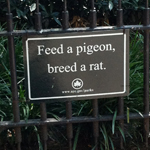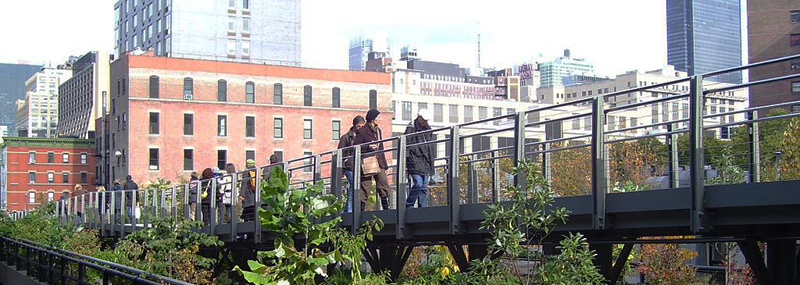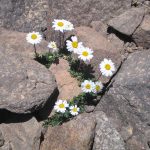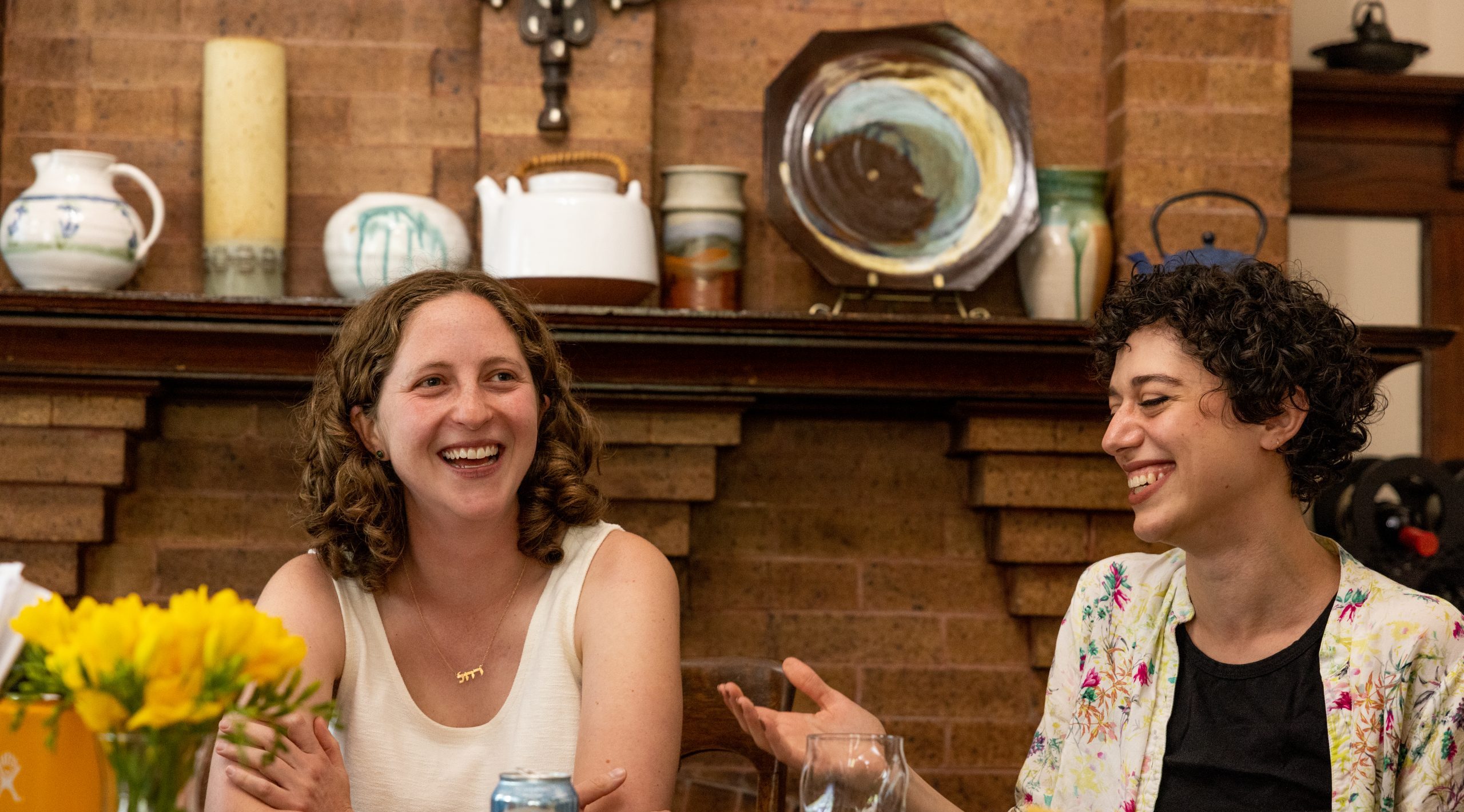
Aug 29, 2012 | by Rabbi Lisa Goldstein, Former Executive Director, Institute for Jewish Spirituality

Earlier in the summer, I went to Roosevelt Island. There is a red tram that takes you from the east side of Manhattan, up, over the Queensboro Bridge and the East River and then down to the island. It’s great fun.
I was early to meet my friend and so I waited at the tram depot on the Manhattan side for a while. The little plaza by the station was one of those strange places that for some reason attracts pigeons by the hundreds. My eye was caught by a sign that the New York City Department of Parks and Recreation posted on a fence: “Feed a Pigeon. Breed a Rat.” (And just for the record, I did indeed spy a rat, roughly the size of a pigeon, scurrying beneath the rose bushes.)
The sign reminded me of a classic teaching story that I first heard from Sheila Weinberg. A Native American elder is teaching a group of children, sitting at his feet. He says, “There are two wolves. One is filled with rage and hatred and blame and fear. The other is filled with compassion and forgiveness and peacefulness and faith. These two wolves are fighting. And they are inside me.”
One of the children asks anxiously, “Which wolf will win?”
The elder solemnly replies, “Whichever one I feed.”
In my experience, my more negative thought patterns are very similar to feeding rats and pigeons. I have no desire to feed the rats. But pigeons are innocuous. I find them  dirty and slightly menacing in a weird way, but they’re certainly not on the same level as rats. In the same way, I don’t intend to hold on to things that make me angry, hateful, fearful or judgmental. But I certainly can find myself nursing small grudges or injustices that seem innocuous.
dirty and slightly menacing in a weird way, but they’re certainly not on the same level as rats. In the same way, I don’t intend to hold on to things that make me angry, hateful, fearful or judgmental. But I certainly can find myself nursing small grudges or injustices that seem innocuous.
But in fact, they are not. The New York City Department of Parks and Recreation is exactly right. Feed a pigeon, breed a rat. Cling to that grievance and it inadvertently may shape my thoughts towards something much darker and unwanted.
Of course, there is a place in the world for all kinds of animals, even those we call pests, and anger, fear and hatred are unavoidable – and occasionally even useful – human experiences. It’s a question of appropriateness and discernment. Perhaps the first place we can stop “feeding the pigeons” is with ourselves – by bringing compassion, forgiveness and faith to our mind’s endless capacity for holding on when we might let go.

Jul 25, 2012 | by Rabbi Lisa Goldstein, Former Executive Director, Institute for Jewish Spirituality
The July retreat season flew quickly by. For me, the hidden jewel of the season was the silent contemplative Shabbat. It combined two things that I treasure as part of my spiritual life: Shabbat and silence.
Shabbat and silence can be surprisingly similar. To the uninitiated, Shabbat can seem like a bunch of rules, mostly involving things you can’t do. But those who regularly observe Shabbat know that the structure of the tradition allows for something magical to happen. By temporarily turning away from the demands of work, entertainment and acquisition, we can make space for experiences of true meaning.
Silence works in a similar way. By temporarily not engaging in social conversation, I make space to find deeper meaning in my own life. My habitual thoughts can rest a little. I give myself time to notice how I am really doing, not just how I want to be doing. What is going on in my heart underneath all the distractions of life? What wisdom can emerge from that knowledge? How does the Divine move through it all?
Some of that I can also do in conversation with someone I trust. But in silence, I don’t have to explain or justify anything to anyone. No one will demand an answer or offer a solution. If I am feeling sad, I can feel sad. If I am feeling alive and grateful, that’s fine. I don’t have to define it or describe it or analyze it. I can just feel it and be it – until it shifts and becomes something else. There is a comfort and a safety in the silence. I can lean into it, knowing it will support me and lead me where I need to go.
It may seem counterintuitive that being quiet with a group of other people who are also in silence is much more powerful than silence alone. And yet, that is true. (At least, that is true for me.) I often feel a strange intimacy and affection for fellow meditators, even when I don’t know any biographical information about them. The silence allows me to remember the fundamentals of being a human being: the longing for love and meaning, the pain of suffering, the inevitable passing of time. The realization that I share those things with every other person becomes a lived experience in silence, not just a beautiful thing to think about.
A silent Shabbat – most coveted of days!

Jun 27, 2012 | by Rabbi Lisa Goldstein, Former Executive Director, Institute for Jewish Spirituality

photo credit: Beyond My Ken
One of my favorite places to bring friends and family who come to visit me in New York is The High Line. The High Line is a former elevated railroad track that ran between the meat packing district and 34th Street. Thanks to the efforts of a handful of visionary citizens, the track is now an elevated park with beautiful gardens, intriguing art pieces, inviting gathering places and unusual third-floor views of the surrounding architecture.
I recently noticed a new art installation by the Israeli-born artist Uri Aran. It is easy to miss at first. But around 25th St, if you listen carefully, you can hear from among dense leaves a voice listing animals. Soon it is apparent that it is listing “good” animals, such as a cat or a platypus, and “bad” animals, such as a spider or shark. The voice is flat and has a slightly pompous tone.

At first, I was nonplused. What exactly makes a platypus a good animal? And why are spiders on the “bad” list? Didn’t Aran read
Charlotte’s Web?? Then I laughed: I was dividing the good and bad list into my own list of good and bad, and in a way that is every bit as arbitrary as the original list. And of course I do that all the time, about the strangers I see on the subway, the things I see in shop windows, the ideas that come into my head: Good. Bad. Good. Bad.
In fact, one of the things I most love about the High Line is that the people who created it were able to see the good in something that the city thought was bad. Here was a rusted, dilapidated eyesore, ready to be demolished. But a few neighbors had the imagination to consider what it could become – a place of wildflowers and gelato, a little urban beach and public art.
It’s a great reminder.

Jun 20, 2012 | by Rabbi Lisa Goldstein, Former Executive Director, Institute for Jewish Spirituality

I just returned from vacation, where I went hiking from village to village in the Atlas Mountains. The Atlas Mountains are very steep and rugged, but people have lived there for as long as anyone can remember. The villages cling to the sides of narrow valleys in neat, terraced rows of mud and stone houses, walnut and cherry orchards and small plots of barley and peas. The trails between the villages are narrow and rocky, created by goats and shepherds over centuries.
As we walked along these ageless paths, I found myself remembering a story I heard as a child, one of those stories that kept me awake wondering at night. There is a huge mountain a mile high. Once every hundred years, an eagle flies low over the mountain and brushes off one grain of sand from the top with the tip of its wing. Think of how long it would take to wear away the entire mountain! And yet, that is only the first second of infinity.
We often think of mountains as the symbol of solidness and durability. One of the teachings of mindfulness, however, is the experience of impermanence, as we observe how the breath moves in and out, how sensation changes, how thoughts arise and pass. And as we hiked, I was struck by how the mountains too are changing all the time due to the rivers washing down rocks and sand, the ice and snow carving the stone, the huge boulders that fall down to the valleys, the footsteps of hundreds of people and animals pressing down, even the alpine flowers that push up through the rocks. These mountains are in fact wearing slowly down. It is just a matter of time and scale.
Of course, if I stop to think about it, I know in my head that not even the mountains are exempt from the law of change. But to look up the valley and experience that fact took me aback for a moment. Then I thought of the blessing for seeing tall and lofty mountains: Blessed are You, God, who performs the work of creation. Who continues to perform, over long and short periods of time.

And I realized again: It is such a blessing to be small and ephemeral, to see the beauty of the world inside us and around us, to glimpse the preciousness of this life, its fragility and glory, and to share it with joy with those around us.

 dirty and slightly menacing in a weird way, but they’re certainly not on the same level as rats. In the same way, I don’t intend to hold on to things that make me angry, hateful, fearful or judgmental. But I certainly can find myself nursing small grudges or injustices that seem innocuous.
dirty and slightly menacing in a weird way, but they’re certainly not on the same level as rats. In the same way, I don’t intend to hold on to things that make me angry, hateful, fearful or judgmental. But I certainly can find myself nursing small grudges or injustices that seem innocuous.









